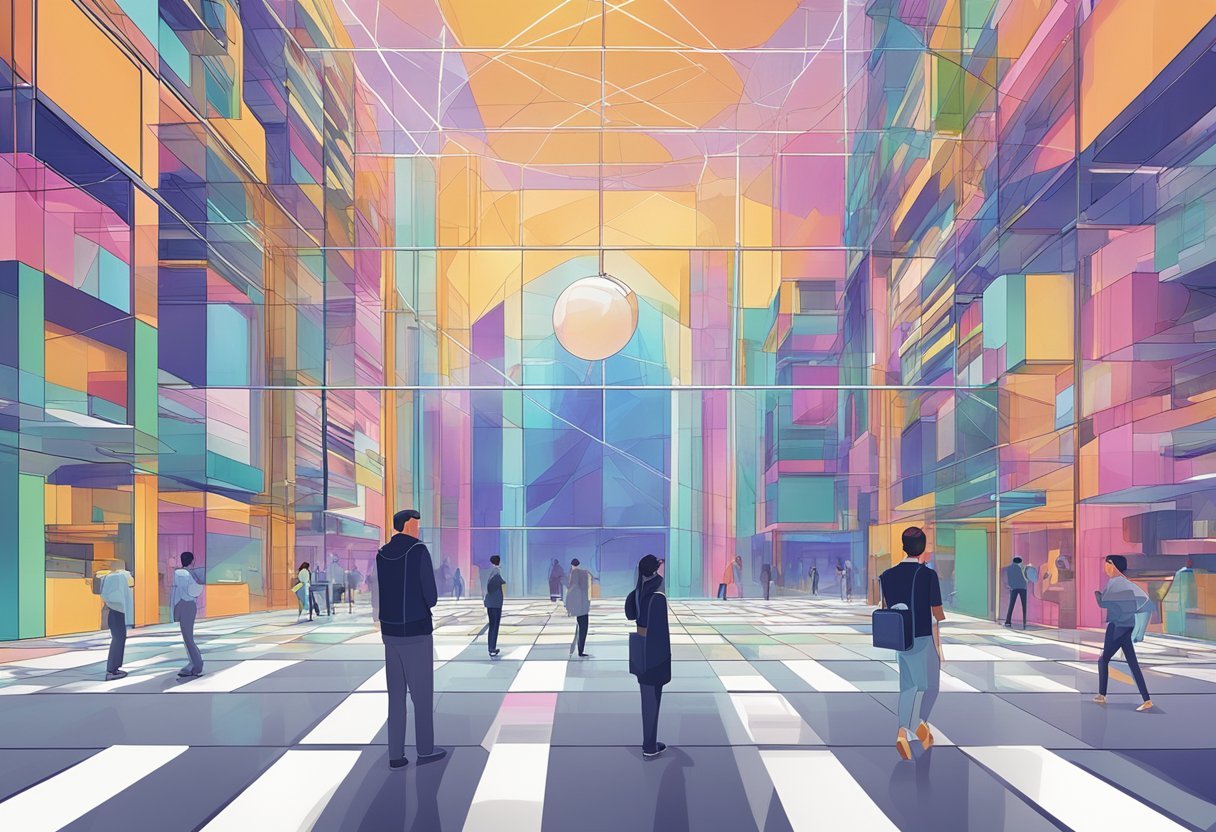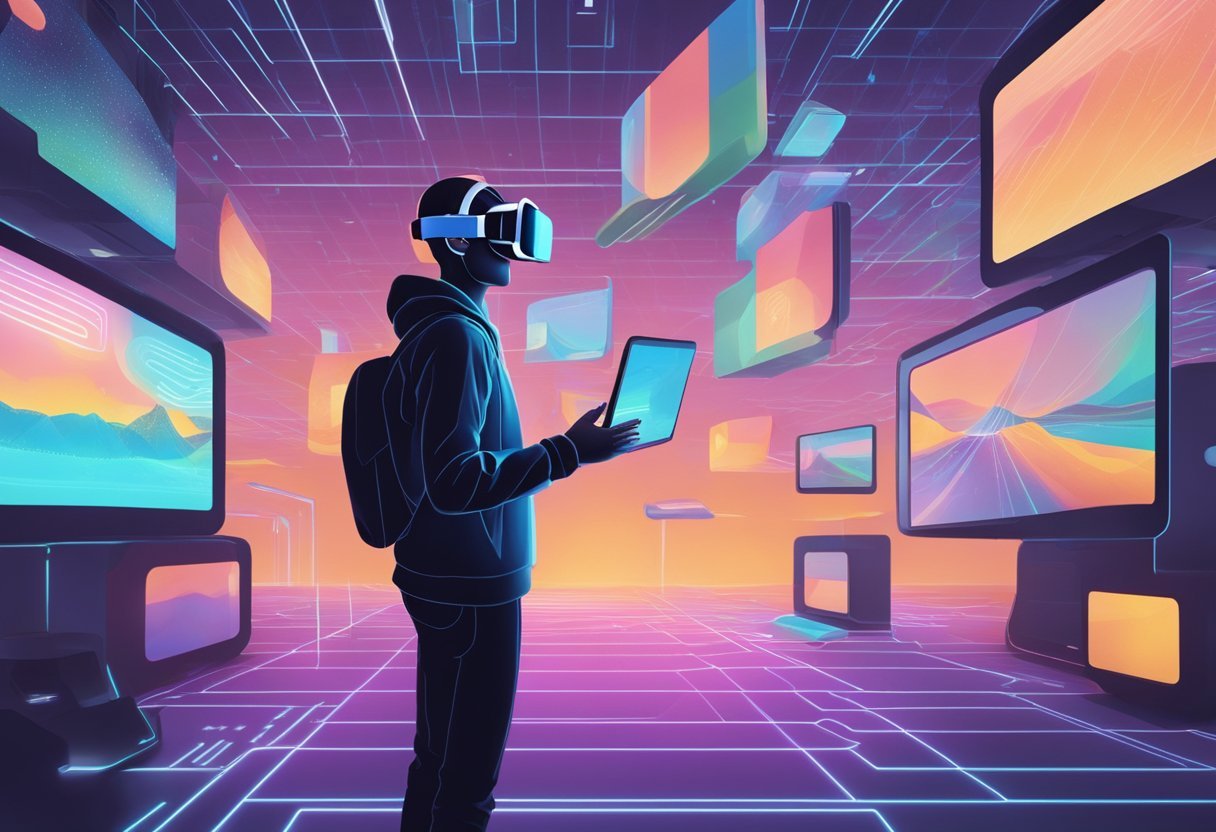The metaverse is a term that has been gaining popularity in recent years. It refers to a virtual world where people can interact with each other and with digital objects in a way that is similar to the physical world. The concept of the metaverse has been around for decades, but recent advances in technology have brought it closer to reality.
One of the key features of the metaverse is that it is a fully immersive environment. Users can create avatars that represent them in the virtual world and interact with other users in real-time. The metaverse is not just a game or a social network, but a new type of online environment that has the potential to revolutionize the way we work, play, and interact with each other.
Facts about the Metaverse
The metaverse is a virtual universe that is rapidly gaining popularity in the tech industry. Here are the top 5 facts about the metaverse:
Fact 1: Origin
The term “metaverse” was first coined by Neal Stephenson in his 1992 novel, Snow Crash. It referred to a virtual universe where people could interact with each other and software applications. The concept has since been expanded to include a variety of virtual environments that can be accessed through the internet.
Fact 2: Evolution of the Internet
The metaverse is considered the next step in the evolution of the internet. It is a fully immersive environment that allows people to interact with each other in real-time, just like in the physical world. The metaverse is expected to revolutionize the way people work, learn, and socialize.
Fact 3: Popularity
The metaverse is gaining popularity among gamers, but it is not just limited to gaming. It is expected to be used for a variety of purposes, including education, healthcare, and entertainment. The metaverse is predicted to become a multi-billion-dollar industry in the coming years.
Fact 4: Access
The metaverse is accessible through virtual reality (VR) headsets, augmented reality (AR) devices, and traditional computer screens. Users can create avatars, which are digital representations of themselves, and interact with other users in the virtual environment.
Fact 5: Challenges
The metaverse faces several challenges, including privacy concerns, security issues, and the potential for addiction. As the metaverse becomes more popular, it will be important to address these challenges to ensure that users can safely and responsibly interact in the virtual environment.
The metaverse is an exciting new technology that has the potential to revolutionize the way people interact with each other and the world around them. However, it is important to address the challenges that come with this new technology to ensure that it is used in a safe and responsible manner.
Myths about the metaverse
The metaverse has been the subject of many speculations and myths. Here are the top five common misconceptions about the metaverse:
Myth #1: No one knows what the metaverse is
This is a common misconception that is far from the truth. The metaverse is a virtual universe that is created by the convergence of physical and virtual reality. It is a shared space where users can interact with each other and engage in various activities. The concept of the metaverse has been around for decades, and it is continually evolving.
Myth #2: The metaverse is only accessible through virtual reality technology
While virtual reality (VR) technology is one of the ways to access the metaverse, it is not the only way. The metaverse can also be accessed through augmented reality (AR), mixed reality (MR), and other technologies. The metaverse is not limited to any specific technology, and it is continually evolving.
Myth #3: The metaverse is only for gamers
The metaverse is not only for gamers. While gaming is one of the primary activities in the metaverse, it is not the only one. The metaverse offers endless possibilities for various activities such as socializing, shopping, learning, and working. The metaverse is a shared space where users can engage in various activities and interact with each other.
Myth #4: The metaverse is a replacement for the real world
The metaverse is not a replacement for the real world. It is a virtual universe that complements the physical world. The metaverse offers endless possibilities for various activities and interactions that are not possible in the physical world. The metaverse is a shared space where users can interact with each other and engage in various activities.
Myth #5: The metaverse is a dystopian future
The metaverse is not a dystopian future. It is a virtual universe that offers endless possibilities for various activities and interactions.
The metaverse is a shared space where users can interact with each other and engage in various activities. The metaverse has the potential to revolutionize the way we interact and engage with each other in virtual environments.
Metaverse Platforms and Experiences Facts
Popular Platforms
The metaverse is composed of various platforms that offer users a virtual experience. Some of the popular platforms include Facebook Horizon Worlds, Decentraland, and Second Life. Facebook Horizon Worlds is a social VR platform that allows users to create and explore virtual worlds.
Decentraland is a decentralized virtual world that enables users to buy, sell, and develop virtual real estate. Second Life is a virtual world that has been around since 2003 and offers users a wide range of activities, including shopping, gaming, and socializing.
Gaming and Entertainment
Gaming and entertainment are a significant part of the metaverse experience. Video games such as Fortnite, Minecraft, and Roblox have integrated the metaverse concept into their gameplay.
Fortnite has introduced concerts and events within the game, while Minecraft has created a virtual world that allows players to build and explore. Roblox offers users the ability to create their games and experiences within the platform.
Virtual Real Estate and Commerce
Virtual real estate and commerce are emerging markets within the metaverse. Decentraland allows users to buy, sell, and develop virtual real estate, creating a new market for virtual land.
E-commerce is also a significant part of the metaverse, with platforms such as Facebook Horizon Worlds and Second Life offering virtual shopping experiences. The metaverse offers a new way for businesses to reach customers in a virtual environment.
The metaverse is a new frontier for social media, gaming, and commerce. As more platforms and experiences emerge, the possibilities for the metaverse are endless.
Metaverse Technological Infrastructure Facts
Hardware and Devices
The hardware and devices used to access the metaverse are critical components of its technological infrastructure. VR headsets, such as those made by Oculus, HTC, and Sony, are the primary devices used to access the metaverse.
These devices are equipped with sensors and cameras that track the user’s movements and translate them into actions within the virtual environment.
AI-powered assistants, such as Apple’s Siri and Google Assistant, are becoming increasingly integrated with metaverse technology, allowing for more natural and intuitive interactions with the virtual environment.
Software and Development
The software used to create and develop the metaverse is another essential component of its technological infrastructure. Unity, a popular game engine, is widely used to create virtual environments and experiences.
NVIDIA’s Omniverse platform is also gaining popularity as a tool for creating and collaborating on 3D designs. Open standards, such as the WebXR API, are crucial for ensuring interoperability and enabling seamless experiences across different devices and platforms.
Interoperability and Standards
Interoperability and open standards are critical for the metaverse to reach its full potential. The metaverse must be accessible to everyone, regardless of the devices or platforms they use.
To achieve this, companies like Qualcomm are working on developing standards for spatial computing, which will enable devices to understand and interact with the physical world.
The creation of open standards, such as the Open Metaverse Interoperability Group (OMG), will ensure that different metaverse platforms can communicate and interact with each other, creating a more connected and seamless virtual environment.
Economic and Social Impact Facts
Digital Economy and Investment
The metaverse is a rapidly growing industry that is attracting significant investment and attention. According to a report by Meta, the adoption of metaverse technology will create new economic opportunities, opening up new markets and business models.
The report also highlights the importance of building the metaverse in a way that is open and interoperable, which will enable collaboration and innovation. The metaverse is also expected to create new investment opportunities, particularly in the areas of NFTs, cryptocurrency, and blockchain technology.
Social Interaction and Communities
The metaverse is a new frontier for social interaction and communities. Users can enter the internet using a digital avatar, which allows them to interact with others in a virtual space. The use of generative AI in the creation of digital avatars is also expected to create new opportunities for self-expression and creativity.
The metaverse is expected to foster the creation of new communities, which will enable people to connect and collaborate in ways that were previously impossible.
The metaverse is a rapidly growing industry that is attracting significant investment and attention. The adoption of metaverse technology will create new economic opportunities, opening up new markets and business models. The metaverse is also a new frontier for social interaction and communities, which will enable people to connect and collaborate in ways that were previously impossible.
Facts about Metaverse challenges
The Metaverse, like any new technology, is not without its challenges. Here are five facts about the challenges that the Metaverse poses:
- Security Concerns: With an increase in the number of users accessing the Metaverse, security concerns have become a significant challenge. The Metaverse is a virtual world where users can create their own content, which makes it vulnerable to hacking, phishing attacks, and identity theft.
- Privacy Issues: Privacy is a significant concern in the Metaverse. Users’ personal information, such as their name, address, and credit card details, are often stored in the Metaverse. This information can be accessed by hackers, leading to identity theft and other privacy violations.
- Governance Challenges: The Metaverse is a decentralized platform, which makes it challenging to govern. There is no central authority to regulate the platform, which can lead to issues such as misinformation, abuse, and targeted advertising.
- Antitrust Concerns: The Metaverse is dominated by a few large companies, which has led to antitrust concerns. These companies have significant control over the Metaverse, which can lead to a lack of competition and innovation.
- Misinformation: The Metaverse is a platform where users can create their own content, which can lead to misinformation. With the rise of deepfakes and other forms of digital manipulation, it can be challenging to distinguish between what is real and what is not.
These are just some of the challenges that the Metaverse poses. As the platform continues to grow and evolve, it is crucial to address these challenges to ensure a safe and secure virtual world for everyone.
Frequently Asked Questions
What is the projected market value of the metaverse by a certain year?
The market value of the metaverse is expected to grow significantly in the coming years. According to a report by Goldman Sachs, the metaverse market could reach a value of $1 trillion by 2030. This projection is based on the growing interest in virtual experiences and the increasing adoption of metaverse platforms.
How has the user base of the metaverse evolved over recent years?
The user base of the metaverse has grown rapidly in recent years. The number of monthly active users (MAU) for leading metaverse platforms has increased significantly.
For example, Second Life, one of the earliest metaverse platforms, has seen its MAU numbers grow from around 800,000 in 2019 to over 1 million in 2023. Similarly, the popular metaverse platform Roblox has seen its MAU numbers grow from 100 million in 2019 to over 200 million in 2023.
What are the current monthly active user (MAU) statistics for leading metaverse platforms?
As of 2023, the leading metaverse platforms have the following monthly active user (MAU) statistics: Roblox – over 200 million, Fortnite – over 350 million, Minecraft – over 140 million, and Second Life – over 1 million. These numbers are expected to continue to grow as more people become interested in virtual experiences.
Can you provide recent statistical data on the metaverse’s growth?
According to a report by Sensor Tower, the metaverse market has seen significant growth in recent years. In the first quarter of 2023, metaverse apps generated over $1 billion in revenue, which is a 400% increase from the same period in 2022. Additionally, the number of downloads for metaverse apps has increased by over 200% in the same period.
How many users are participating in the metaverse from different countries?
The metaverse has a global user base, with users participating from different countries around the world. According to a report by Statista, the countries with the highest number of metaverse users as of 2023 are the United States, China, and Japan. However, there is also significant participation from other countries, including the United Kingdom, Germany, and South Korea.
What are some notable advancements in the development of the metaverse?
There have been several notable advancements in the development of the metaverse in recent years. One of the most significant is the development of virtual reality (VR) technology, which has enabled more immersive and realistic virtual experiences.
There have been advancements in artificial intelligence (AI) and blockchain technology, which have the potential to enhance the functionality and security of metaverse platforms.




